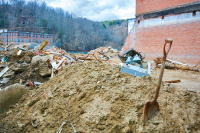Three new developments move forward in Waynesville
At a time when Waynesville’s appearance standards are under scrutiny for being too strict, three proposed developments cruised past the town’s Community Appearance Commission.
Last week, the advisory board approved the Noland Retail Center and Holland Car Wash, both on South Main Street near Wal-Mart, and a new Verizon Wireless store on Russ Avenue.
Such smooth sailing for these three projects seems incongruous with claims that the standards are potentially driving developers away.
But there are easy explanations for why these projects passed the community appearance board relatively quickly, said Daniel Hyatt, landscape architect and project manager for the Noland Retail Center and Holland Car Wash.
According to Hyatt, developers who hire local designers are generally familiar with the types of developments the town desires. They can draft a site plan that meets the standards without revisiting the drawing board multiple times. The retail center and the car wash proved that by passing the appearance board on their first try.
But that approval alone is insufficient to begin building, as the appearance board serves only in an advisory capacity.
Related Items
“Make no mistake, we still have a sizeable amount of work to do on both of these projects to make the letter of the ordinance,” said Hyatt, who recused himself as chairman of the community appearance board to present the two projects.
Corporate developers usually come to the table with the same site plans they’ve used time and again. These are the developers who are less likely to bend to the will of the town.
“When they come into a community like Waynesville that has fairly restrictive design requirements, then they have a lot of difficulty,” said Hyatt. “It gives them a lot of heartburn.”
None of the three projects will have to come back to the board unless there’s a drastic change in the site plan, Hickox said.
Scrutinizing the standards
While the design standards promote pedestrian usage, they don’t take into account auto-centric businesses, like drive-thrus, car washes and pay-at-the-pump gas stations.
The town’s standards push parking lots to the side or rear of buildings rather than in front — a move aimed at creating a more appealing streetscape where attractive building facades, instead of asphalt, take center stage. But some businesses were left out.
“Nobody thought when they put the land development standards in, how are we going to make a gas station work under these,” said Hickox.
The steering committee that’s reviewing the land development standards has also placed the appearance commission under the microscope.
Since the standards went into effect in 2003, the appearance board has sometimes been stymied because it can only make recommendations to developers, not demands.
The other obstacle in the commission’s path is that it is the first stop in the permit chain, very early on in the process.
“At which time, a lot of the details aren’t really worked out,” said Hyatt.
Developers can only paint pictures with broad brushstrokes for the appearance board. For example, they can only point out where the large trees or small trees might go, not provide details like the genus and species of every plant.
As the steering committee works to improve the standards and take these concerns into account, the public is invited to take part.
Anyone can get involved in the process by crafting and presenting a well-thought amendment, Hickox said.
Hyatt himself appreciates the chance to work on the standards before they are vetted by the public, town board and town staff.
“It’s nice to be clued in on the front of this discussion,” said Hyatt.









